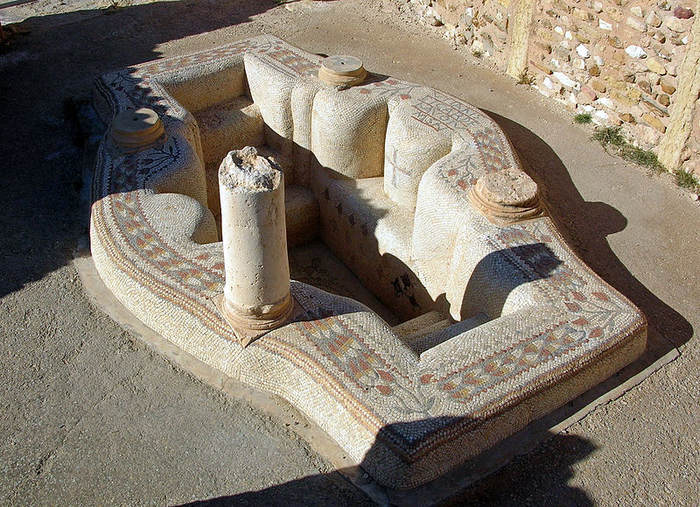A glamorous new religion needs glamorous old rituals. Fri 27 May 2022
Step-in baptistry, Church of Vitalis, Sbeitla, Tunisia. Source: Early Christian Baptismal Imagery for Today 1
And on the other side of the Mediterranean:
Baptistery at the Basilica of St John, Ephesus, Turkey. Source: Baptistery - Wikipedia 2
Step-in baptistries are found in the former Roman colonies.
And everywhere else:
The Lord is her shepherd too. Source: Sheep dip
Shepherds' crooks also appear in 'ancient' baptistry signage:
John the Baptist shoulders his crook. Source: Arian Baptistry, Ravenna
At the Church of Vitalis baptistry, four wide columns supported a roof. Judging by their width, it was a heavy roof. Perhaps a cistern.
Its four slots look as though boards or planks could be dropped in to hold individual livestock in place while problems were inspected or treated.
The baptistry's design looks ideal for treating head lice and pubic lice (crabs). Unwelcome guests on humans destined for slave markets or for skin and hair harvesting.
Think of it as new product inspection. Source: Into the Badlands
The 'step-in, walk through, step-out' design of early baptistries suggests they were built to process many individuals one after another. Perhaps to de-louse slaves before they were taken to the souk. The soke. The market.
Not surprisingly, baptism left personal hygiene with a bad name.
From Is the Phrase "Cleanliness Is Next to Godliness" Biblical?:
from the 1500’s until about 1800’s bathing sort of fell out of fashion. People actually believed bathing could be unhealthy!
And from The Origins of “Cleanliness Is Next to Godliness”:
Contrary to the common impression, the ancient world put a lot of emphasis on bathing and cleanliness, with the Romans going so far as to invent indoor plumbing. The Middle Ages also, with the encouragement of the Church, took a lot of baths, with population centers having public bathhouses. Not until the early Modern era through the Enlightenment of the 18th century did people get the idea that taking baths may be unhealthy.
How then, did bathing - and voluntary baptism - become fashionable again?

Dove detail from Palatine Chapel baptism mosaic.
And:

Dove detail from Arian Baptistry mosaic.
Doves. Seemingly associated with a sparkling liquid.
From Arian Baptistry - Wikipedia:
Above, the Holy Spirit in the form of a dove sprays lustral water from its beak.
Lustral water?
Yes, lustral water. It has a colourful history:
A petroleum leak creates lustral lake water. Source: Water Sheen Facts
Petroleum-derived lustral water was used as an insecticide as late as the 1950s:
Kerosene spray as anti-malaria control, 1945. Source: An Alternate History of DDT
His pipe - and perhaps the infant - suggest this photograph was staged. For those that know petroleum's history as 'lustral water', the image looks like an in-joke; a play on "baptism by fire". Nevertheless, the point remains. So effective an insecticide was petroleum-based lustral water that it was still sometimes sprayed alongside DDT after that chemical hit the market in 1944.
'Restored' mosaics advertising lustral water suggest 19th century promoters of soaps, detergents, degreasants and pesticides ensured their products were part of Christian myth.
From Using God to Sell Soap:
soap companies marketed their products in distinctly religious terms.

Lustral water is still good business. Source: Dove Shampoo
Using God to Sell Soap cites Allegories of Progress: Industrial Religion in the United States, a 2010 paper by Richard J. Callahan, Jr., Kathryn Lofton, and Chad E. Seales. In a section titled 'The Consumption of Cleanliness', they claim soap company adverts successfully linked the use of soap with Christian salvation.
From Allegories of Progress: Industrial Religion in the United States:
In the 1870s, soap was seen as an optional accessory to daily life; by the 1930s, soap ranked second to food as the most important product in people’s home.
this was an era when producers learned not only how to make products efficiently, but also how to teach consumers what they needed to do with those products
Through its exonerating agency, soap offered not only sanitation, but explicit salvation.
Not just in the States but in Canada, says the paper. And - apparently - around Rome's Mediterranean colonies.
Would a soap manufacturer really pay to mosaic an 'ancient' Italian baptistry?
Sure they would. A well-placed mosaic could turn a new-looking roadside rebuild into an ancient temple of hygiene:
The Arian Baptistry's 'ancient' exterior. Source: Arian Baptistry - Wikipedia
In other words, profits from the prophet.
Nor are we the only ones to find ourselves pinned beneath a bird in a make-believe world:
It's a doppelganger special! Source: The Truman Show
Locations in this evidence collection
Key:
- Blue marker: Baptistry with lustral water mosaic
- Red marker: Baptistry resembling a sheep dip
- Green marker: Catacomb of Callixtus, Rome
© All rights reserved. The original author retains ownership and rights.
-
Possible late fake: From Archaeological site of Sbeitla: It was excavated and restored between 1906 and 1921. ↩
-
Possible late fake: From Basilica of St. John: Little is known about the Basilica of St. John, with its only source being from a small description. The text then showers readers with remarkably precise details about its construction history and usage. ↩
More of this investigation:
The Georgian Birth of Christ,
More of this investigation:
The Mutant Chimp Gets a Culture
More by tag:
#prostitution, #medieval retail, #Manimal Farm






